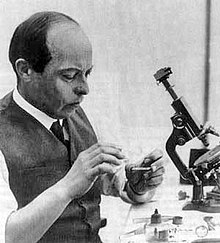Wladyslaw Starewicz
Ladislas Starevich (* July 27 jul. / 8. August 1882 greg. In Moscow , † 26 February 1965 in Fontenay-sous-Bois ) was a Russian puppet animation filmmaker of Polish origin, the pioneer of stop motion heard and technology often used prepared insects and animal figures as protagonists in his films. He started his work in Russia and continued it in France after the October Revolution . In addition to the Polish name form used here, there are also the spellings Wladislaw Alexandrowitsch Starewitsch (Russian), Ladislas Starevitch / Starewitch (French / mostly used by him in France), Ladislas Starevich (English), Ladislaus Starewitsch (German).
Life
Starewicz was born to Polish parents from Lithuania . His mother died in 1886. He grew up with his maternal grandparents in Kaunas . He became interested in drawing and painting, writing and acting and began collecting butterflies. On November 25, 1906, he married Anna Zimmermann († 1956); the following year their daughter Irène († 1992) was born, who had assisted her father in film production since the 1920s and who, after his death, campaigned for the preservation of the films. In 1913 his second daughter Jeanne was born († 1984). In the early 1920s the family settled in France.
Career
In the Russian Empire
Starewicz worked in the land registry office in Kaunas and was active in his spare time as a theater actor and photographer. Through contacts with the city's national and natural history museum, he made his first film in 1909, one of four documentaries for the museum. His work for the insectology department resulted in his first animated film using stop-motion technology, Lucanus Cervus , in 1910 , which portrays a fight between two stag beetles . He is said to have been inspired by Émile Cohl's Les allumettes animées (1908).
As a result, Starewicz wrote and staged his own scripts with animated insects, including The Ant and the Grasshopper (1913). He first removed the limbs of the insects and then reattached them with wax to create the mobility required for animation. In 1912 Starewicz went to Moscow and worked for Alexander Chanschonkov's film production company . There he shot numerous short doll cartoons with insects and self-made dolls. The best known of these are The Beautiful Ljukanida and The Revenge of the Cameraman (both 1912), which also received international attention. Some of his directorial work were also feature films, including Snegurotschka (1914) and Ruslan and Ludmilla (1915) with the well-known actor Ivan Mosschuchin .
During the First World War, Starewicz worked for various production companies and in 1917 moved from Moscow to Yalta in the Crimea . From there he fled after the October Revolution via Italy to France, where he adopted the simpler form of the name “Ladislas Starewitch”.
In France
From 1920/21 he began to produce puppet cartoons independently and exclusively in France. His first film in French exile was Les Grenouilles qui demandent un roi (1922), a political fable based on Aesop . Among his most respected films belongs to the hand-colored film La Voix du rossignol / The Voice of the Nightingale (1923), L'horloge magique / The Zauberuhr (1928) and Fétiche Mascotte (1934). La Voix du rossignol received a gold medal for best short film in the USA in 1925.
In 1928 Starewicz signed a production contract with Louis Nalpas . His first feature film, Reineke Fuchs , was produced in Paris between 1929 and 1931, but had its world premiere in Berlin in 1937 and was released in France in 1941 (as a talkie ). At the time of its premiere, it was only the second full-length puppet film ever. The new requirements of sound and later color films made production conditions difficult, but Starewicz continued to produce, especially in the late 1940s, until his death. Zanzabelle in Paris was awarded the gold medal for the best children's film at the Venice Film Festival in 1947, while Fern Flower received the first prize for the best animated film at the 11th Venice Children's Film Festival in 1949.
Starewicz picked up the dolls he and his wife had created, many of them animal figures, and mostly used them as supporting characters in later films. He died while working on the film Comme chien et chat / Like Dog and Cat , which was left unfinished out of respect.
Web links
- Ladislas Starevich in the Internet Movie Database (English)
- extensive biography with photos and some clips
- Tribute to Starewitch (designed by his granddaughter)
- Article Władysław Starewicz in the Great Soviet Encyclopedia (BSE) , 3rd edition 1969–1978 (Russian)
- some of his early films on UbuWeb
- for broadcasting Die Wunderuhr and Der Zauberwald on ARTE
- Biography with many photos (spanish)
Footnotes
- ↑ some sources list him as one of the two founders of the museum
- ↑ Article in the New York Times of December 17, 1925 ( Memento of the original of March 5, 2016 in the Internet Archive ) Info: The archive link was automatically inserted and not yet checked. Please check the original and archive link according to the instructions and then remove this notice.
| personal data | |
|---|---|
| SURNAME | Starewicz, Wladyslaw |
| ALTERNATIVE NAMES | Starevich, Wladislaw Alexandrovich; Starevitch, Ladislas; Starewitch, Ladislas; Starevich, Ladislas; Starevich, Ladislaus |
| BRIEF DESCRIPTION | Polish puppet filmmaker, pioneer of stop motion technology |
| DATE OF BIRTH | August 8, 1882 |
| PLACE OF BIRTH | Moscow |
| DATE OF DEATH | February 26, 1965 |
| Place of death | Fontenay-sous-Bois , France |
